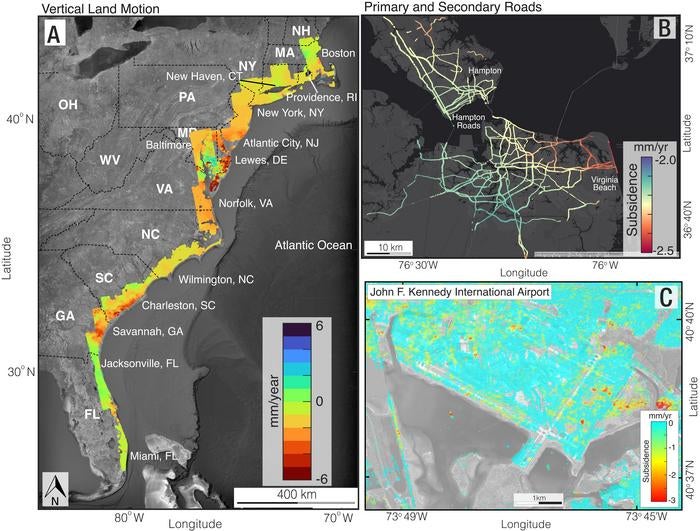Sinking US cities already face ‘real impacts’ as subsidence poses risk to buildings and roads
‘Hotspots of sinking land intersect directly with population and infrastructure hubs,’ researchers warn
Your support helps us to tell the story
From reproductive rights to climate change to Big Tech, The Independent is on the ground when the story is developing. Whether it's investigating the financials of Elon Musk's pro-Trump PAC or producing our latest documentary, 'The A Word', which shines a light on the American women fighting for reproductive rights, we know how important it is to parse out the facts from the messaging.
At such a critical moment in US history, we need reporters on the ground. Your donation allows us to keep sending journalists to speak to both sides of the story.
The Independent is trusted by Americans across the entire political spectrum. And unlike many other quality news outlets, we choose not to lock Americans out of our reporting and analysis with paywalls. We believe quality journalism should be available to everyone, paid for by those who can afford it.
Your support makes all the difference.Major cities on the US’s Atlantic coast are sinking faster than previously thought, with some rates of subsidence outpacing global sea level rise and threatening buildings, roads, and other key infrastructure.
Urban centres including New York City, Long Island, Baltimore, Virginia Beach, and Norfolk are seeing areas sinking by as much as 5mm per year, according to new research published in the journal PNAS Nexus.
Such rapid sinking can undermine building foundations, damage roads, gas and water lines and exacerbate coastal flooding – especially when paired with sea level rise along the coast caused by climate change, researchers warn.
“Continuous unmitigated subsidence on the US East Coast should cause concern,” study lead author Leonard Ohenhen from Virginia Tech said.
“This is particularly in areas with a high population and property density and a historical complacency toward infrastructure maintenance,” Dr Ohenhen said.
Analysing data from several sources, including space-based radar satellites, scientists built digital maps showing exactly where sinking landscapes present risks to the health of vital infrastructure.
They measured millions of occurrences of land subsidence spanning multiple years and created some of the world’s first high-resolution maps of the process.

A large area of the East Coast is sinking at least 2 mm per year, a change that affects over 2 million people and 800,000 properties, researchers found.
“The problem is that the hotspots of sinking land intersect directly with population and infrastructure hubs,” Dr Ohenhen said.
Up to 3,700 square km (over 1,400 square miles) is sinking at more than 5 mm per year – more than the current 4 mm per year global rate of sea level rise – the study found.
Overall, scientists say about 2,000 to 74,000 square km of land area, home to 1.2 to 14 million people and 476,000 to 6.3 million properties, and more than half of all infrastructure in major cities such as New York, Baltimore, and Norfolk are exposed to subsidence rates between 1 and 2 mm per year.
“Through this study, we highlight that the sinking of land is not an intangible threat. It affects you and I and everyone, it may be gradual, but the impacts are real,” Manoochehr Shirzaei, another author of the study, said.
Citing an example of the effects of this subsidence, researchers say significant areas of critical infrastructure in New York, such as the JFK and LaGuardia airports and its runways, along with the railway systems, are affected.
“The effects of these right now and into the future are potential damage to infrastructure and increased flood risks,” Dr Ohenhen added.

Join our commenting forum
Join thought-provoking conversations, follow other Independent readers and see their replies
Comments